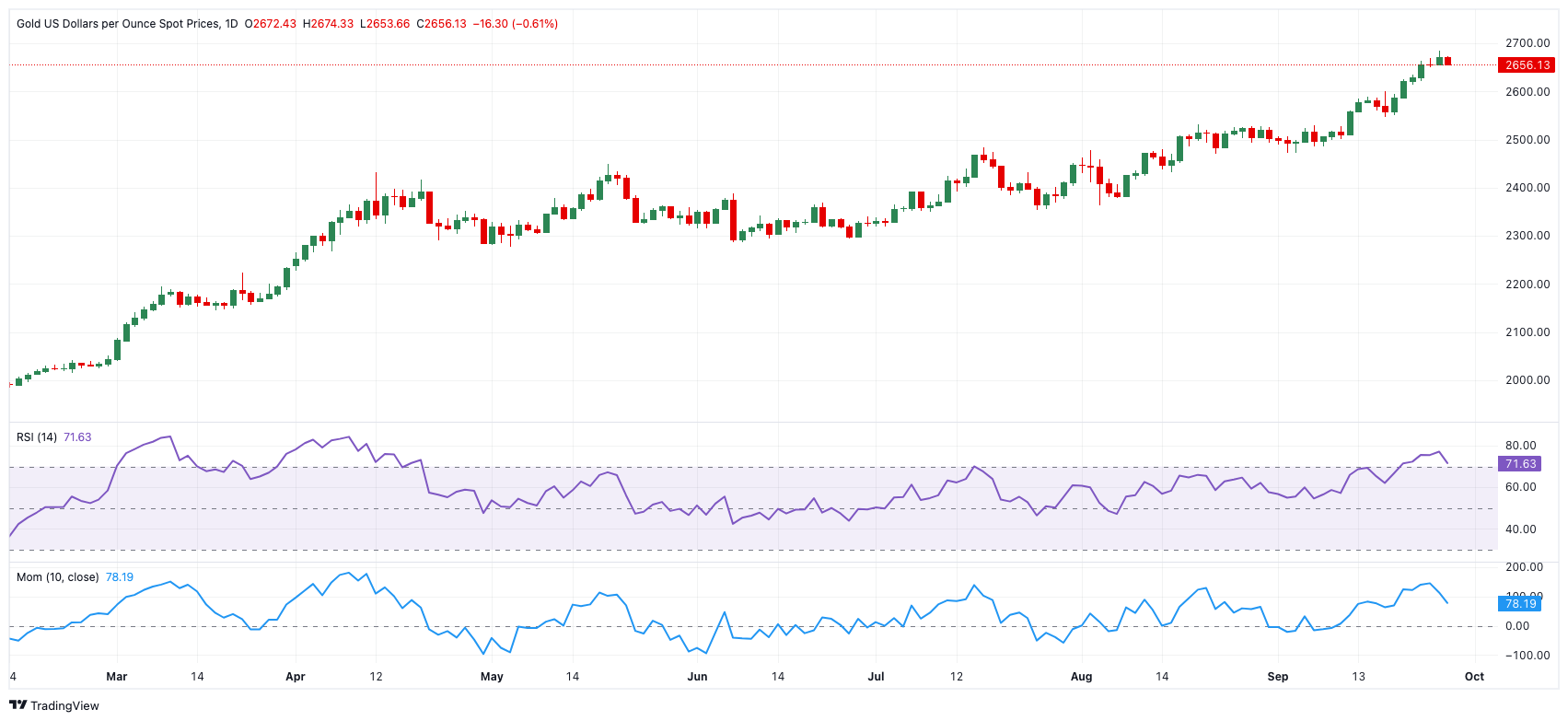- Gold clinched its third consecutive week of gains, reaching a fresh all-time high on Thursday.
- If bullish momentum persists, immediately to the upside emerges the $2,700 mark.
- Fed rate cut bets, geopolitical tensions continue to support the yellow metal.
Gold (XAU/USD) extended its positive performance this week, hitting all-time tops in levels just shy of the $2,700 mark per ounce troy on Thursday.
The rally in the precious metal remained propped up by, firstly, steady expectations of extra interest rate reductions by the Federal Reserve (Fed) in the upcoming couple of meetings and well into 2025, and secondly, incessant geopolitical concerns stemming mainly from the Middle East, while the Russia-Ukraine conflict also adds to the matter.
Last but not least, contributing to the uptrend in bullion, also emerged the equally persevering offered stance of the US Dollar (USD).
Next on tap… $3,000?
As the US Dollar approaches its third consecutive week of losses, Gold prices are set to mark their third straight week of gains.
Since late June, traders have continued to shift towards the non-yielding metal pari passu growing expectations of Fed interest rate cuts, which culminated in a significant 50-basis-point (bps) reduction at the Fed’s meeting on September 18.
However, market participants did not seem quite satisfied with the Fed's outsized move. That said, investors still expect around 75 bps of easing by the central bank for the remainder of the year, according to the CME FedWatch tool.
Looking at the longer run, investors expect between 100 and 125 bps of interest rate reductions by the end of 2025.
Against this backdrop, it is not surprising that the yellow metal could have already embarked on a probable visit to the key $3,000 level, which will apparently hit sooner rather than later. However, the current overbought market conditions might call for some common sense, allowing some short-term corrective decline.
At this point, and in light of the strong rally observed in Gold prices, a “purge” would be more than welcomed by those afraid of entering the market at current levels, at the same time giving another chance to those part of the fear of missing out (FOMO) space.
Geopolitical effervescence continues to support the uptrend
Another driver of the important move higher in the precious metal is the unabated geopolitical jitters surrounding the Israel-Hamas crisis, as well as the Russia-Ukraine conflict, which will likely enter its third year in February.
The flight-to-safety adage comes to the fore every time news hits the wires about the deterioration of any of these scenarios, which unfortunately do not appear to be over any time soon.
And the US Dollar?
The Greenback has been on a firm bearish leg since July, accompanied by increasing speculation of extra monetary policy easing by the Fed. Now that the central bank has started its rate cut cycle, and with inflation kind of firmly navigating towards the 2% target, hopes for a sustained recovery of the US Dollar seem to dim on a daily basis, at least in the near future.
Gold technical outlook
As we mentioned above, Gold’s current overbought conditions, as per the daily RSI around 75, leave the door open for a near-term correction.
However, the constructive outlook appears to be everything but abated. That said, there is an immediate up-barrier at the record peak of $2,685 (Thursday’s high) and the round-level of $2,700. Once this level is surpassed, the Fibonacci extensions of the 2024 uptrend emerge at $2,876, seconded by $2,975 and then $3,119.
Let’s say sellers regain some initiative. In this scenario, there is an initial contention at the weekly low of $2,546 (September 18), which comes ahead of the September low of $2,471 (September 4) and precedes the transitory 100-day SMA at $2,428.
From a technical perspective, the metal’s positive outlook should remain unchanged as long as it trades above the key 200-day SMA at $2,288.
Economic Indicator
Nonfarm Payrolls
The Nonfarm Payrolls release presents the number of new jobs created in the US during the previous month in all non-agricultural businesses; it is released by the US Bureau of Labor Statistics (BLS). The monthly changes in payrolls can be extremely volatile. The number is also subject to strong reviews, which can also trigger volatility in the Forex board. Generally speaking, a high reading is seen as bullish for the US Dollar (USD), while a low reading is seen as bearish, although previous months' reviews and the Unemployment Rate are as relevant as the headline figure. The market's reaction, therefore, depends on how the market assesses all the data contained in the BLS report as a whole.
Read more.Next release: Fri Oct 04, 2024 12:30
Frequency: Monthly
Consensus: 145K
Previous: 142K
Source: US Bureau of Labor Statistics
America’s monthly jobs report is considered the most important economic indicator for forex traders. Released on the first Friday following the reported month, the change in the number of positions is closely correlated with the overall performance of the economy and is monitored by policymakers. Full employment is one of the Federal Reserve’s mandates and it considers developments in the labor market when setting its policies, thus impacting currencies. Despite several leading indicators shaping estimates, Nonfarm Payrolls tend to surprise markets and trigger substantial volatility. Actual figures beating the consensus tend to be USD bullish.
Employment FAQs
Labor market conditions are a key element in assessing the health of an economy and thus a key driver for currency valuation. High employment, or low unemployment, has positive implications for consumer spending and economic growth, boosting the value of the local currency. Moreover, a very tight labor market – a situation in which there is a shortage of workers to fill open positions – can also have implications on inflation levels because low labor supply and high demand leads to higher wages.
The pace at which salaries are growing in an economy is key for policymakers. High wage growth means that households have more money to spend, usually leading to price increases in consumer goods. In contrast to more volatile sources of inflation such as energy prices, wage growth is seen as a key component of underlying and persisting inflation as salary increases are unlikely to be undone. Central banks around the world pay close attention to wage growth data when deciding on monetary policy.
The weight that each central bank assigns to labor market conditions depends on its objectives. Some central banks explicitly have mandates related to the labor market beyond controlling inflation levels. The US Federal Reserve (Fed), for example, has the dual mandate of promoting maximum employment and stable prices. Meanwhile, the European Central Bank’s (ECB) sole mandate is to keep inflation under control. Still, and despite whatever mandates they have, labor market conditions are an important factor for policymakers given their significance as a gauge of the health of the economy and their direct relationship to inflation.
Information on these pages contains forward-looking statements that involve risks and uncertainties. Markets and instruments profiled on this page are for informational purposes only and should not in any way come across as a recommendation to buy or sell in these assets. You should do your own thorough research before making any investment decisions. FXStreet does not in any way guarantee that this information is free from mistakes, errors, or material misstatements. It also does not guarantee that this information is of a timely nature. Investing in Open Markets involves a great deal of risk, including the loss of all or a portion of your investment, as well as emotional distress. All risks, losses and costs associated with investing, including total loss of principal, are your responsibility. The views and opinions expressed in this article are those of the authors and do not necessarily reflect the official policy or position of FXStreet nor its advertisers. The author will not be held responsible for information that is found at the end of links posted on this page.
If not otherwise explicitly mentioned in the body of the article, at the time of writing, the author has no position in any stock mentioned in this article and no business relationship with any company mentioned. The author has not received compensation for writing this article, other than from FXStreet.
FXStreet and the author do not provide personalized recommendations. The author makes no representations as to the accuracy, completeness, or suitability of this information. FXStreet and the author will not be liable for any errors, omissions or any losses, injuries or damages arising from this information and its display or use. Errors and omissions excepted.
The author and FXStreet are not registered investment advisors and nothing in this article is intended to be investment advice.
Recommended Content
Editors’ Picks

AUD/USD flirts with this year highs as USD resumes slide
The Australian Dollar surged against its American rival approaching the yearly high of 0.6437. The cautious tone of equities was not enough to help the Greenback, weighed by trade tensions between the US and China.

Gold extends gains towards $3,350
Gold price slowly advanced on Monday, starting the new day just ahead of the $3,350 amid broad US Dollar weakness. Caution kept market activity limited ahead of first-tier data releases next Wednesday.

EUR/USD extends gains beyond 1.1400 amid renewed USD weakness
EUR/USD hovers around 1.1420 early on Tuesday, regaining the upside amid concerns about global economic progress within the ongoing trade war between Washington and Beijing. European and US growth in the eye of the storm.

Bitcoin: Will Trump’s 100-Day speech propel BTC above $100,000?
Bitcoin rebounds as high as $95,490 on Monday, as Trump’s 100-day speech dominates macro news. On-chain data shows BTC deposits on exchanges declined by $4 billion in the past week. Here’s how these insights could impact Bitcoin $100,000 breakout prospects in the near-term.

Week ahead: US GDP, inflation and jobs in focus amid tariff mess – BoJ meets
Barrage of US data to shed light on US economy as tariff war heats up. GDP, PCE inflation and nonfarm payrolls reports to headline the week. Bank of Japan to hold rates but may downgrade growth outlook. Eurozone and Australian CPI also on the agenda, Canadians go to the polls.

The Best brokers to trade EUR/USD
SPONSORED Discover the top brokers for trading EUR/USD in 2025. Our list features brokers with competitive spreads, fast execution, and powerful platforms. Whether you're a beginner or an expert, find the right partner to navigate the dynamic Forex market.
